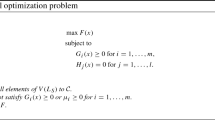Abstract
Mixtures of group-based Markov models of evolution correspond to joins of toric varieties. In this paper, we establish a large number of cases for which these phylogenetic join varieties realize their expected dimension, meaning that they are nondefective. Nondefectiveness is not only interesting from a geometric point-of-view, but has been used to establish combinatorial identifiability for several classes of phylogenetic mixture models. Our focus is on group-based models where the equivalence classes of identified parameters are orbits of a subgroup of the automorphism group of the abelian group defining the model. In particular, we show that for these group-based models, the variety corresponding to the mixture of r trees with n leaves is nondefective when \(n \ge 2r+5\). We also give improved bounds for claw trees and give computational evidence that 2-tree and 3-tree mixtures are nondefective for small n.
Similar content being viewed by others
References
Abo H, Brambilla MC (2012) New examples of defective secant varieties of Segre–Veronese varieties. Collectanea Mathematica 63(3):287–297
Abo H, Brambilla MC (2013) On the dimensions of secant varieties of Segre-Veronese varieties. Annali di Matematica Pura ed Applicata 192(1):1–32
Alexander J, Hirschowitz A (1995) Polynomial interpolation in several variables. J Algebraic Geom 4(2):201–222
Allman ES, Petrović S, Rhodes JA, Sullivant S (2011) Identifiability of 2-tree mixtures for group-based models. IEEE/ACM Trans Comput Biol Bioinf 8(3):710–722
Baños H, Bushek N, Davidson R, Gross E, Harris PE, Krone R, Long C, Stewart A, Walker R (2016) Phylogenetic trees. arXiv preprint arXiv:1611.05805 (2016)
Buczynska W, Wisniewski JA (2007) On the geometry of binary symmetric models of phylogenetic trees. J Eur Mathe Soc 9(3):609–635
Casanellas M (2012) Algebraic tools for evolutionary biology. Math Soc 12–17
Daskalakis C, Mossel E, Roch S (2011) Evolutionary trees and the ising model on the Bethe lattice: a proof of steel’s conjecture. Probab Theory Rel Fields 149(1):149–189
Draisma J (2008) A tropical approach to secant dimensions. J Pure Appl Algebra 212(2):349–363
Evans SN, Speed TP (1993) Invariants of some probability models used in phylogenetic inference. Ann Stat 21(1):355–377
Grayson DR, Stillman ME (2002) Macaulay 2, a software system for research in algebraic geometry
Hendy MD, Penny D, Steel MA (1994) A discrete fourier analysis for evolutionary trees. Proc Natl Acad Sci 91(8):3339–3343
Jukes TH, Cantor CR (1969) Evolution of protein molecules. Mamm Protein Metab 3(21):132
Long C, Sullivant S (2015) Identifiability of 3-class Jukes–Cantor mixtures. Adv Appl Math 64:89–110, 3
Mauhar M, Rusinko J, Vernon Z (2017) H-representation of the kimura-3 polytope for the m-claw tree. SIAM J Discret Math 31(2):783–795
Michałek M (2011) Geometry of phylogenetic group-based models. J Algebra 339(1):339–356
Neyman J (1971) Molecular studies of evolution: a source of novel statistical problems. Stat Decis Theory Rel Top 1:1–27
Pagel M, Meade A (2004) A phylogenetic mixture model for detecting pattern-heterogeneity in gene sequence or character-state data. Syst Biol 53(4):571–581
Sturmfels B (1996) Gröbner bases and Convex Polytopes, vol 8. American Mathematical Society, Providence
Sturmfels B, Sullivant S (2005) Toric ideals of phylogenetic invariants. J Comput Biol 12(2):204–228
Sullivant S (2018) Algebraic statistics. Graduate studies in mathematics. American Mathematical Society, Providence
Acknowledgements
This work began at the 2016 AMS Mathematics Research Community on “Algebraic Statistics,” which was supported by the National Science Foundation under Grant number DMS-1321794. RD was supported by NSF DMS-1401591. EG was supported by NSF DMS-1620109. RW was supported by a NSF GRF under Grant number PGF-031543, NSF RTG Grant 0943832, and a Ford Foundation Dissertation Fellowship. HB was supported in part by a research assistantship, funded by the National Institutes of Health Grant R01 GM117590. PEH was partially supported by NSF Grant DMS-1620202.
Author information
Authors and Affiliations
Corresponding author
Rights and permissions
About this article
Cite this article
Baños, H., Bushek, N., Davidson, R. et al. Dimensions of Group-Based Phylogenetic Mixtures. Bull Math Biol 81, 316–336 (2019). https://doi.org/10.1007/s11538-018-0489-0
Received:
Accepted:
Published:
Issue Date:
DOI: https://doi.org/10.1007/s11538-018-0489-0




